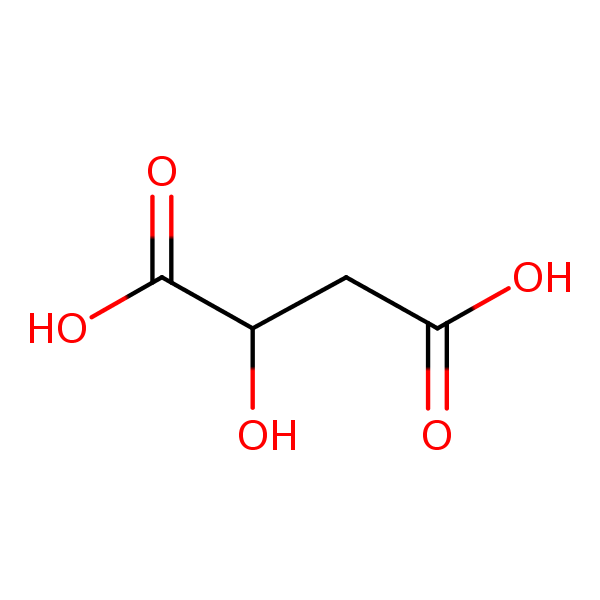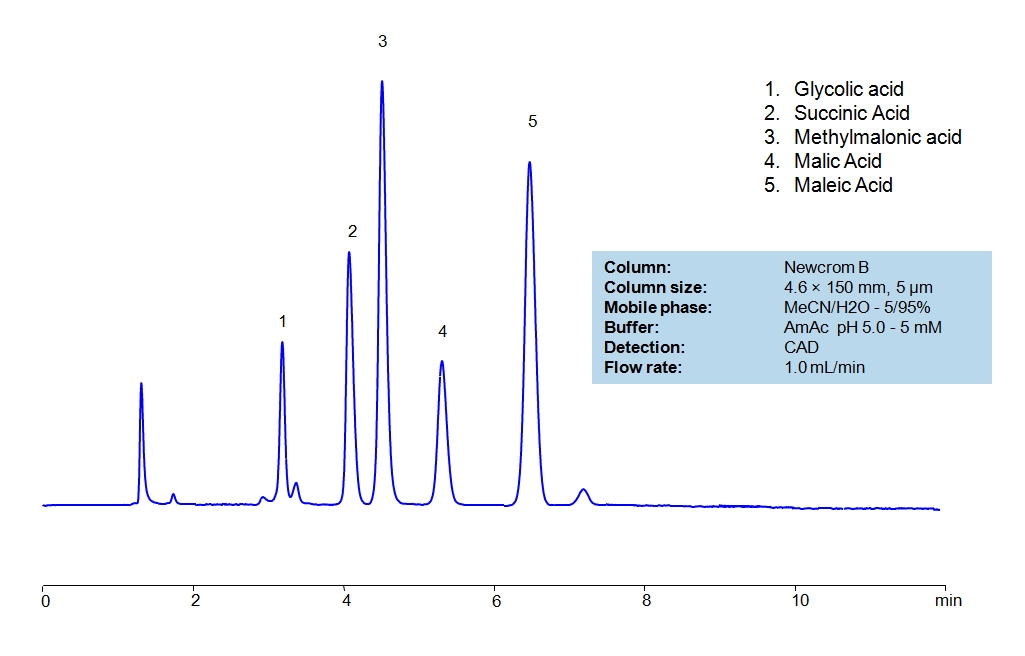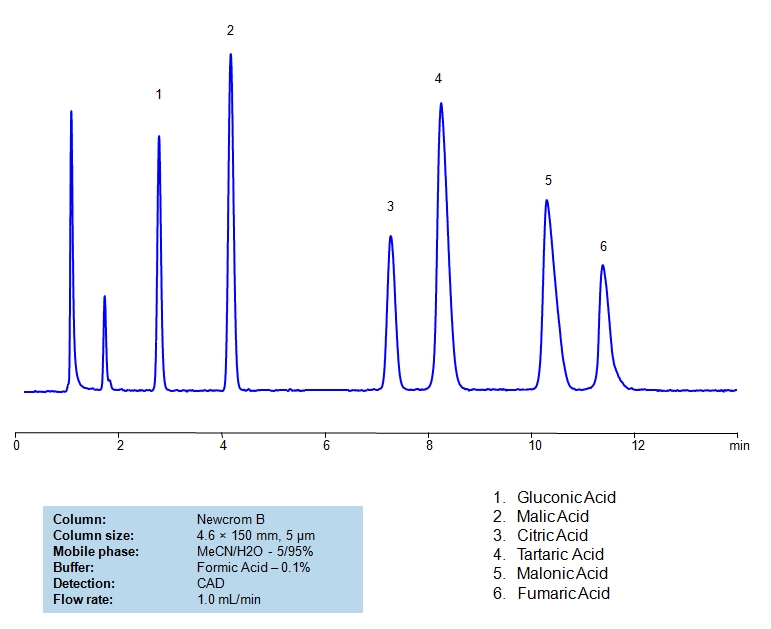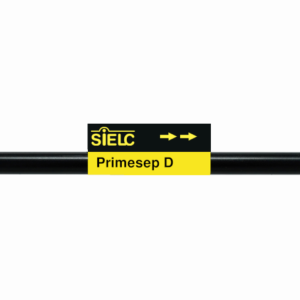| CAS Number | 6915-15-7 |
|---|---|
| Molecular Formula | C4H6O5 |
| Molecular Weight | 134.088 |
| InChI Key | BJEPYKJPYRNKOW-UHFFFAOYSA-N |
| LogP | -1.26 |
| Synonyms |
|
Applications:
HPLC Separation of Small Organic Acids on Newcrom B Column
October 22, 2019
| Column | Newcrom B, 4.6×150 mm, 5 µm, 100A |
| Mobile Phase | MeCN/H2O – 5/95% |
| Buffer | AmAc pH 5.0, Formic Acid |
| Flow Rate | 1.0 ml/min |
| Detection | CAD (Corona) MS- compatible mobile phase |
| Class of Compounds | Acid, Hydrophilic, Ionizable |
| Analyzing Compounds | Glycolic acid, Succinic Acid, Methylmalonic acid, Malic Acid, Maleic Acid, Citric Acid, Tartaric Acid, Fumaric Acid, Malonic Acid |
Application Column
Newcrom B
The Newcrom columns are a family of reverse-phase-based columns. Newcrom A, AH, B, and BH are all mixed-mode columns with either positive or negative ion-pairing groups attached to either short (25 Å) or long (100 Å) ligand chains. Newcrom R1 is a special reverse-phase column with low silanol activity.
Select optionsFumaric Acid
Gluconic acid
Glycolic acid
Maleic Acid
Malic Acid
Malonic Acid
Methylmalonic Acid
Succinic Acid
Tartaric Acid
dl-Tartaric acid

Separation of Compounds in TCA Cycle on Primesep D Column
July 3, 2013
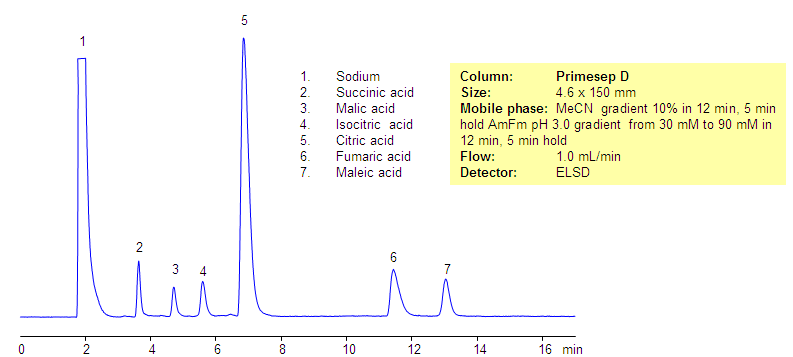
The citric acid cycle (tricarboxylic acid cycle, Krebs cycle) is a key process in the metabolic pathway by which all aerobic organisms generate energy. Compounds generated during TCA are hydrophilic, acidic compounds. Some of the hydrophilic acids are very strong while others are relatively weaker. All compounds have very low hydrophobicity and do not retain by the reversed-phase mechanism on the C18 or C8 HPLC columns. Citric acid and related products were separated in reversed-phase, anion-exchange mode on the Primesep D mixed-mode column. All hydrophilic, acidic compounds are well separated and demonstrate good shape. This robust method can be used for analysis of components of the TCA cycle and other highly hydrophilic compounds. This method is fully compatible with LC/MS and prep chromatography.
| Column | Primesep D, 4.6×150 mm, 5 µm, 100A |
| Mobile Phase | MeCN/H2O |
| Buffer | AmFm, pH 3.0 |
| Flow Rate | 1.0 ml/min |
| Detection | ELSD |
| Class of Compounds |
Acid, Hydrophilic, Ionizable |
| Analyzing Compounds | Sodium, Succinic acid, Malic acid, Isocitric acid, Citric acid, Fumaric acid, Maleic acid |
Application Column
Primesep D
The Primesep family of mixed-mode columns offers a wide variety of stationary phases, boasting unprecedented selectivity in the separation of a broad array of chemical compounds across multiple applications. Corresponding Primesep guard columns, available with all stationary phases, do not require holders. SIELC provides a method development service available to all customers. Inquire about our specially-tailored custom LC-phases for specific separations.
Select optionsFumaric Acid
Isocitric Acid
Maleic Acid
Malic Acid
Sodium
Succinic Acid

Analysis of Compounds of TCA Cycle on SHARC 1 Column
July 2, 2013
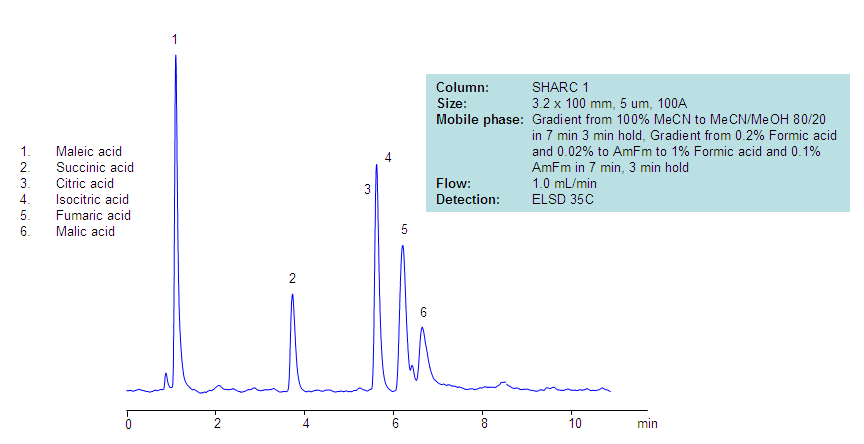
This is an alternative approach for the separation of the TCA cycle intermediates that was developed using novel hydrogen-bonding HPLC column. The organic nature of the mobile phase helps obtain a highly sensitive LC/MS compatible method.
Application Column
SHARC 1
The SHARC™ family of innovative columns represents the first commercially available columns primarily utilizing separation based on hydrogen bonding. SHARC stands for Specific Hydrogen-bond Adsorption Resolution Column. Hydrogen bonding involves an interaction or attraction between a bound hydrogen atom and molecules containing electronegative atoms, such as oxygen, nitrogen, and fluorine.
Select optionsFumaric Acid
Isocitric Acid
Maleic Acid
Malic Acid
Succinic Acid

HPLC Separation of Organic Acids
July 10, 2012
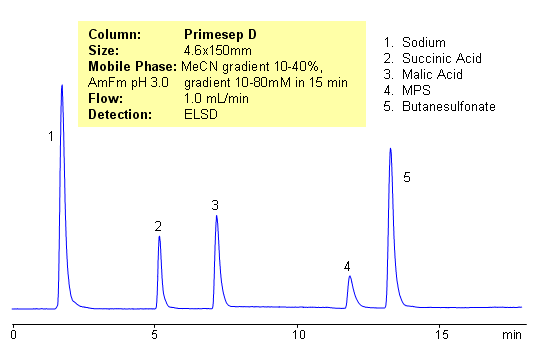
Primesep D mixed-mode column separates organic acids such as succinic acid, malic acid, MPS and butanesulfonate by a mixture of anion exchange and reversed phase mechanisms. Retention times can be changed by adjusting the percentage of acetonitrile in the mobile phase. This can not be done by traditional ion-exchange and ion-exclusion chromatography. The HPLC separation uses a mobile phase of water, acetonitrile (MeCN, ACN) and ammonium formate as a buffer, making the method MS-compatible. Can also use UV detection at 250 nm.
| Column | Primesep D, 4.6×150 mm, 5 µm, 100A |
| Mobile Phase | MeCN/H2O |
| Buffer | AmFm |
| Flow Rate | 1.0 ml/min |
| Detection | ELSD |
| Class of Compounds |
Acid, Hydrophilic, Ionizable |
| Analyzing Compounds | Sodium, Succinic Acid, Malic Acid, MPS, Butanesulfonate |
Application Column
Primesep D
The Primesep family of mixed-mode columns offers a wide variety of stationary phases, boasting unprecedented selectivity in the separation of a broad array of chemical compounds across multiple applications. Corresponding Primesep guard columns, available with all stationary phases, do not require holders. SIELC provides a method development service available to all customers. Inquire about our specially-tailored custom LC-phases for specific separations.
Select optionsMalic Acid
Organic Acids
Sodium
Succinic Acid
UV Detection

HILIC Separation of Carboxylic Acids
August 22, 2008
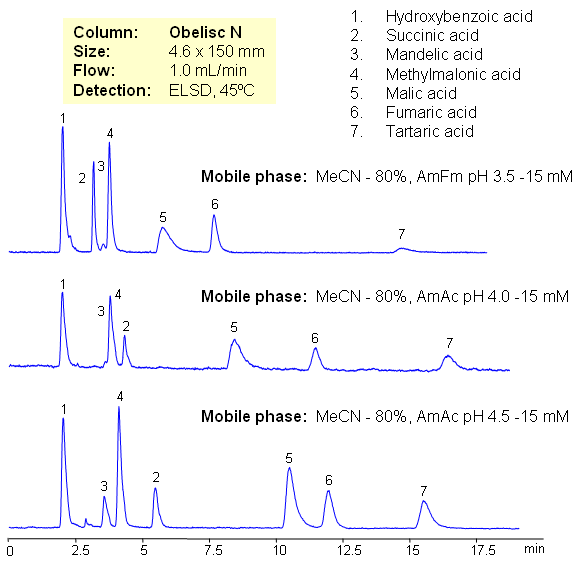
Hydrophilic acids are separated on Obelisc N mixed-mode HILIC column. Seven carboxylic acids are separated based on their polarity and pKa values. Changes in ionization states of acids and stationary phase can be used to control elution order of organic and inorganic acids.
Application Column
Obelisc N
SIELC has developed the Obelisc™ columns, which are mixed-mode and utilize Liquid Separation Cell technology (LiSC™). These cost-effective columns are the first of their kind to be commercially available and can replace multiple HPLC columns, including reversed-phase (RP), AQ-type reversed-phase, polar-embedded group RP columns, normal-phase, cation-exchange, anion-exchange, ion-exclusion, and HILIC (Hydrophilic Interaction Liquid Chromatography) columns. By controlling just three orthogonal method parameters - buffer concentration, buffer pH, and organic modifier concentration - users can adjust the column properties with pinpoint precision to separate complex mixtures.
Select optionsHydroxybenzoic Acid
Malic Acid
Mandelic Acid
Methylmalonic Acid
Organic Acids
Succinic Acid
Tartaric Acid

Separation of Diacid Hydrophobic and Ion Exclusion Modes
October 4, 2005
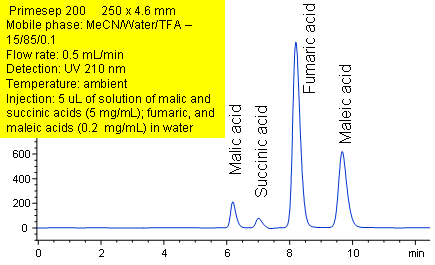
Primesep 200 retains and separates the organic diacids (malic, succinic, fumaric, and maleic) by a combination hydrophobic, reversed-phase interactions and ion exclusion. The separation uses a mobile phase of water, acetonitrile (MeCN, ACN) and trifluoracetic acid (TFA) with UV detection at 210 nm.
Application Column
Primesep 200
The Primesep family of mixed-mode columns offers a wide variety of stationary phases, boasting unprecedented selectivity in the separation of a broad array of chemical compounds across multiple applications. Corresponding Primesep guard columns, available with all stationary phases, do not require holders. SIELC provides a method development service available to all customers. Inquire about our specially-tailored custom LC-phases for specific separations.
Select optionsFumaric Acid
Maleic Acid
Malic Acid
Succinic Acid

Separation of Diacid: Ion Exclusion mode
August 6, 2003
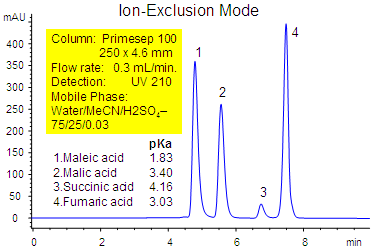
Primesep 100 separates a mixture of dicarboxylic acids in ion-exclusion mode with a mobile phase of water, acetonitrile (MeCN, ACN), and sulfuric acid (H2SO4) with UV detection at 210 nm. Baseline resolution of fumaric, maleic, malic, and succinic acids is obtained in less than 8 minutes. The separation combines ion-exclusion and reversed-phase mechanisms in one method.
Application Column
Primesep 100
The Primesep family of mixed-mode columns offers a wide variety of stationary phases, boasting unprecedented selectivity in the separation of a broad array of chemical compounds across multiple applications. Corresponding Primesep guard columns, available with all stationary phases, do not require holders. SIELC provides a method development service available to all customers. Inquire about our specially-tailored custom LC-phases for specific separations.
Select optionsFumaric Acid
Maleic Acid
Malic Acid
Succinic Acid

